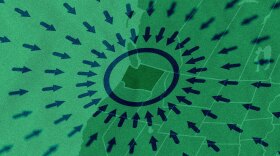After a summer of digging, paleontologists hauled four dinosaurs back to the Burke Museum in Seattle. These dinosaurs were excavated from rocks that are millions of years old — a process that required jackhammers, tractors and trucks.
When they were alive, these dinosaurs roamed a northeastern Montana that resembled a coastal seaway, with meandering rivers and rich vegetation.
Scientists will study these fossils to unlock clues about earth's most recent mass extinction. They hope to use this information to learn more about our future as we perhaps teeter on the edge of another mass extinction, but it’s not easy to draw conclusions from the rock record.

“It’s very hard to go back to a crime scene that happened 66 million years ago ... and try to tease apart enough patterns that make sense of it and relate it to something that happens today,” Greg Wilson Mantilla, the Burke Museum’s curator of vertebrate paleontology, said.
KNKX’s Anya Steinberg traveled to the Burke Museum lab to meet the people preparing and analyzing these fossils.






